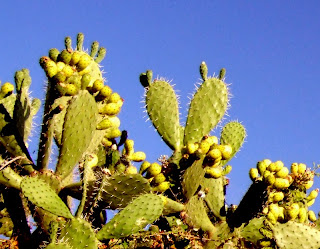Mumbo Chumbo
The prickly-pear cactus, or chumbera, grows profusely in and around Alcalá. It is used for hedges, being fast-growing, hardy and totally livestock-proof, and sprouts along the side of the roads like piles of disorganised green plates growing randomly out of each other. We have a big tangle of it on the hill behind our house, where it provides refuge and food for countless small birds. The fruits are known as higos chumbos, or more commonly, just chumbos. Higo means fig, as when they were first bought to Spain from the Americas - possibly by Columbus himself - people confused them with the Indian fig. They rapidly spread across southern Europe and North Africa and were later introduced to Australia and South Africa.
 |
| CHUMBERAS BEHIND OUR HOUSE |
"Now when you pick a pawpaw, Or a prickly pear
And you prick a raw paw, next time beware
Don't pick the prickly pear by the paw
When you pick a pear, try to use the claw!"
Good advice there from Balou the Bear in the Jungle Book movie. They can attack in two ways; the long sharp smooth spikes, and small hairlike spines called glochids which can penetrate skin and cause sores round the mouth if the fruit is eaten without being cleaned properly. One way of getting rid of the glochids is to rotate the fruit in a flame.
 |
| CHUMBO FLOWERS AND SPINES |
A possibly apocryphal story of which the chumbo is a key protagonist concerns a family who moved from Alcalá to Hawaii in 1911 to work in the sugar cane plantations. Although they were relatively well paid, the father, José Soto, eventually became homesick for his native town. They couldn´t afford the passage, but one day he noticed that his daughter had dyed her lips red with chumbo juice. He started surreptitiously eating large quantities of them until his urine had turned bright red. After a few weeks with no change in his condition his employers feared that he was suffering from an incurable and possibly contagious illness, and agreed to release him from his contract and repatriate his family. Miraculously, as soon as he had the travel papers in his pocket, his urine returned to normal ...

Comments